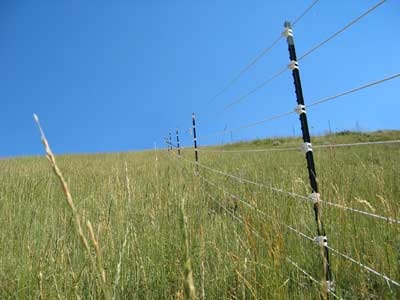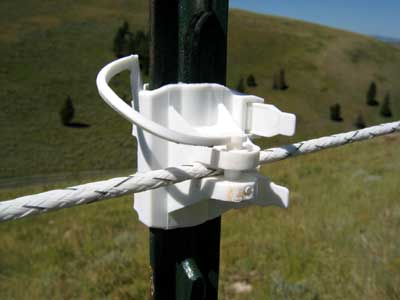Plastic Mesh Fences and Electric Fences Monitored by Satellite Telemetry
Fence Details
The three types of exclosures are relatively easy to install. Any of these 1-acre exclosures can be installed in 1 day with a six- to eightperson crew. Accessibility, terrain, rocks, trees, brush, roots, moisture, clay, equipment accessibility, and the amount of fencing experience of the workers all factor into the time required to install the fence.
This 6-foot-tall, seven-rope fence is supported by metal T-posts with insulators (figure 5). Heavy-duty, 8-footlong T-posts were driven every 20 feet. Pounding steel posts can be difficult in dry, rocky soil. MTDC designed a special driver for setting 10-foot-long T-posts (figure 6). Tech Tip 0324–2340–MTDC (Manual Post Drivers for 8- to 10-Foot- Long Metal Posts, http://www.fs.fed.us/t-d/pubs, username: t-d, password: t-d, search for post driver) and the mechanical drawing (MTDC-1026) of the post driver are available from MTDC.

Figure 5—The 6-foot-tall polyrope electric fence has metal T-post
supports spaced every 20 feet.

Figure 6—A fence post driver designed by MTDC helps workers
install
10-foot-long metal fence posts without using ladders.
Braces using 10-foot long T-posts and special hardware connectors support the corners and gate opening. Porcelain insulators are tied to the corner and end posts with 12-gauge high-tensile wire on 10-inch spacing. Plastic T-post insulators are attached to posts between the corners with two built-in nylon ties (figure 7). In past tests, standard snap-on insulators tended to pop off T-posts.

Figure 7—Plastic strap-on insulators clamp tightly to the T-post and pin the
polyrope at the proper
spacing. Standard snap-on insulators tend to pop off.
Polyrope (Gallagher Turbo Horse Rope) was used on the exposed sides of this fence exclosure. The rope is ¼-inch diameter polyethylene braided rope (polyrope) with nine strands of highly conductive metal filaments. Joint clamps (part number G603044) from Gallagher (figure 8) are used to anchor the rope to the porcelain insulators. Gallagher Rapid Wire Tighteners were used to tension the ropes. A Gallagher B260 energizer supplies electricity. The fence was hooked up as an alternating hot- and ground-wired system with a three-rod grounding system.

Figure 8—Special clamps tie off polyrope to insulators and connect
the rope
to the energizer and
ground wires.
It is advisable to install at least one gate on all exclosures in case an animal finds a way in and becomes trapped. A gate that is 20 feet wide or wider is recommended on electric fences because the animals will be hesitant to approach the edges of the opening of an electric fence.
Plastic Mesh Fence (Nonelectric)
This 7 ½-foot-tall fence was supported by metal T-posts and had three horizontal tension wires. The 10-footlong, heavy-duty metal T-posts were driven 2 ½ feet deep. The posts were spaced 20 feet apart. Braces using two T-posts welded together and special hardware connectors support corners and gate openings (figures 9a and 9b). High-tensile steel wire coated with polyvinyl chloride (PVC) is stretched and tied between corners and gates, along the top, bottom, and middle of the posts. The wires clip to the T-posts after they have been tensioned with Gallagher Rapid Wire Tighteners.

Figure 9a—Corner and end posts on the polyrope and plastic mesh fences
are
braced with T-posts
using special hardware connectors that
install with a hammer.

Figure 9b—Detailed view of a corner post.
The mesh material is made of polypropylene plastic and comes in 7 ½-foot-wide rolls that are 164 feet long. MTDC chose a heavy-duty 1 ¾-inchsquare mesh, Cintoflex-P, manufactured by Tenax, because it was more likely to withstand the heavy snow loading at Buffalo Springs and last at least 8 years. The plastic mesh attaches to the T-post with nylon ties and to the tension wires with hog ring staples (figure 10). The plastic mesh is sandwiched between the T-post and a length of No. 4 rebar that helps hold the mesh tight to the T-post. The rebar helps keep the mesh from tearing out at the nylon ties (figure 11). Another option would be to use more ties at the posts and eliminate the rebar. Getting some of the slack out of the fence, especially around swales or dips, is an issue. Straighten out puckers by pulling loose areas tight with nylon ties. Driving extra fence posts and adding extra plastic mesh may help in ditches or low areas.

Figure 10—Hog rings every
couple
of feet hold the plastic
mesh fence
to high-tensile
wires stretched
between posts.

Figure 11—A piece of rebar
helps hold the mesh tight
along the full
length of the
post.
Nylon cable ties hold
the rebar to the T-post.

